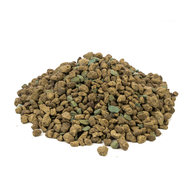Om je kamerplant optimaal te laten groeien, is het belangrijk dat je de juiste soort grond gebruikt voor je planten. Dat kan een universele potgrond zijn, maar ook een substraat of combinatie van beide. Een goede bodem moet er voor zorgen dat jouw kamerplant op de juiste manier water, voeding en zuurstof krijgt.
Wat is potgrond eigenlijk?
Potgrond is eigenlijk niets anders dan een mix van verschillende grondstoffen, waarbij veen vaak als basismateriaal wordt genomen. Afhankelijk van de toepassing wordt dit aangevuld met onder andere zand, kokosvezels, kalk, boomschors en meststoffen. Door verschillende mixen te maken, ontstaat er voor iedere kamerplant een geschikte voedingsbodem. Hieronder vind je de meest gebruikte samenstellingen.
Potgrond voor kamerplanten
Universele kamerplanten potgrond is eigenlijk een basismateriaal wat voor (vrijwel) alle groene kamerplanten geschikt is. Alleen voor cactussen en vetplanten is deze potgrond minder geschikt, omdat hij te lang vocht vasthoudt. Als je universele kamerplanten potgrond koopt, dan is het goed om te weten dat hier ook direct al de benodigde voedingsstoffen voor je plant in zitten voor een langere periode.
Kamerplanten grond »
Potgrond voor kamerpalmen
Heb je een mooie palm gekocht en wil je die oppotten of wordt jouw bestaande kamerpalm te groot, dan kun je deze oppotten met behulp van kamerpalmen grond. Deze grond is geschikt voor alle palmen in huis. In de grond zit direct voeding voor enkele maanden.
Palmen grond »
Potgrond voor Cactussen en vetplanten
Wanneer je vetplanten of cactussen wilt gaan verpotten, dan is een luchtigere potgrond wenselijk. Hierdoor kan de aarde sneller drogen, dit is belangrijk omdat cactussen en vetplanten nooit te lang met hun wortels in een vochtige grond mogen staan.
Cactussen grond »
Je potgrond naar een hoger niveau tillen
Potgrond is een vrij eenvoudig mengsel wat in beginsel prima volstaat voor je kamerplant of palm. Echter is gewone potgrond vrij compact en klinkt het iedere keer dat je water geeft in (alsof de grond iedere keer een beetje aangedrukt wordt). Gevolg is dat er steeds minder zuurstof de wortels kan bereiken. Bij wat kleinere kamerplanten geeft dit over het algemeen weinig problemen, bij grotere kamerplanten en palmen kan dit door te tijd nadelig zijn. Bij grotere planten en palmen raden we je daarom aan om de potgrond met ca. 20% aan te mengen met Perliet (Perlite). Deze korrels zijn zeer licht van gewicht en maken de potgrond aanzienlijk luchtiger, iets wat de wortels van de gemiddelde kamerplant/ kamerpalm zeer kunnen waarderen.
Perliet »
TIP: Ook als je plantjes wilt stekken is het raadzaam om wat Perliet toe te voegen aan je potgrond. Stekjes wortelen het beste in een luchtige grond.
Professionele substraten zoals Zeoponic / Vulcastrat / Lechuza Pon
De potgrond mixen zoals hierboven beschreven, zijn eigenlijk voor alle soorten kamerplanten toereikend. Echter gebruiken professionals liever een substraat zoals Zeoponic, Vulcastrat of Lechuza Pon. Het voordeel is dat dit materiaal niet in klinkt, meer vocht kan opnemen en de kans op ziektes en rouwvliegjes kleiner is. Veel voordelen, maar wel prijziger in aanschaf.
In de basis zijn deze substraten vrijwel identiek, dit substraat/ materiaal is erg poreus en kan daardoor veel vocht opnemen/ bufferen. Het vocht wordt opgezogen door het substraat en langzaam weer afgegeven aan de wortels van je kamerplant. In onderstaande video zie je hoe een gewone kamerplant wordt opgepot met een professioneel substraat.
Tekst gaat verder onder video..
Als je voor een professioneel substraat gaat, dan raad ik je aan om voor de Lechuza Pon te gaan. Deze heeft van alle 3 de beste eigenschappen en is ook voorzien van voeding. Als je Lechuza pon gebruikt, dan hoef je de eerste 6 maanden geen voeding te geven.
Lechuza Pon »
